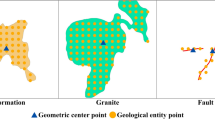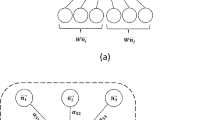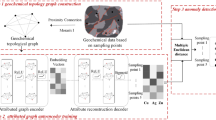Abstract
Mineral prospectivity mapping (MPM) aims to reduce the areas for searching of mineral deposits. Various statistical models that have been successfully adopted to delineate prospecting regions for a specific type of mineral deposit can be divided into pixel-wise, image- (or pixel-patch), and graph-based approaches. The pixel-wise models, which frequently integrate multiple prospecting information (or evidence layers) at a single pixel, do not adequately consider the spatial associations among neighboring pixels and may ignore the spatial patterns linked to mineralization or the spatial distribution characteristics of mineral deposits to some extent. Image-based models such as convolutional neural networks (CNNs) can extract local meaningful features and capture the spatial patterns of prospecting information in MPM because the input data of image-based models are images composed of regular pixels in the Euclidean space. However, CNNs also have limitations in MPM, such as the requirement for regular input data and non-rotationally invariant spatial features. Graphs that are typically composed of nodes and edges have a strong abstraction to capture the complex and nonlinear spatial relationships among multiple nodes and their edges. Prospecting information or evidence layers can be regarded as graphs in which pixels are connected by their adjacent pixels. In this study, graph deep learning algorithms, including graph convolutional networks and graph attention networks, were employed to produce mineral potential maps. A comparative study of graph deep learning algorithms with a CNN demonstrated the advantage of graph deep learning algorithms for MPM in terms of the cumulative areas versus the cumulative number of mineral deposits and the true/false prediction rate plot. These results suggest that the graph-based models, such as graph neutral networks, can effectively capture mineralization information and the spatial interrelations between mineralization and prospecting information.












Similar content being viewed by others
References
Agterberg FP (1989) Computer programs for mineral exploration. Science 245:76–81. https://doi.org/10.1126/science.245.4913.76
Ashish V, Noam S, Niki P, Jakob U, Llion J, Aidan NG, Lukasz K, Illia P (2017) Attention is all you need. Adv Neural Inform Process Syst 30:445
Bahdanau D, Cho K, Bengio Y (2016) Neural machine translation by jointly learning to align and translate. arXiv preprint arXiv:1409.0473
Bonham-Carter GF (1994) Geographic information systems for geoscientists: modelling with GIS. Pergamon Press, p 398
Bronstein MM, Bruna J, LeCun Y, Szlam A, Vandergheynst P (2017) Geometric deep learning: going beyond euclidean data. IEEE Signal Process Mag 34:18–42. https://doi.org/10.1109/MSP.2017.2693418
Carranza EJM (2008) Geochemical anomaly and mineral prospectivity mapping in GIS: Amsterdam. In: Hale M (ed) Handbook of exploration and environmental geochemistry. Elsevier, New York, p 351
Carranza EJM, Laborte AG (2015) Data-driven predictive mapping of gold prospectivity, Baguio district, Philippines: application of random forests algorithm. Ore Geol Rev 71:777–787. https://doi.org/10.1016/j.oregeorev.2014.08.010
Carranza EJM, Hale M (2001) Logistic regression for geologically constrained mapping of gold potential, Baguio district, Philippines. Explor Min Geol 10:165–175. https://doi.org/10.2113/0100165
Carranza EJM, Hale M (2003) Evidential belief functions for data-driven geologically constrained mapping of gold potential, Baguio district, Philippines. Ore Geol Rev 22:117–132. https://doi.org/10.1016/S0169-1368(02)00111-7
Carranza EJM, Hale M (2002) Where are porphyry copper deposits spatially localized? A case study in Benguet province, Philippines. Nat Resour Res 11:45–59. https://doi.org/10.1023/A:1014287720379
Carranza EJM, Mangaoang JC, Hale M (1999) Application of mineral exploration models and GIS to generate mineral potential maps as input for optimum land-use planning in the Philippines. Nat Resour Res 8:165–173. https://doi.org/10.1023/A:1021846820568
Chen J, Jiao L, Liu X, Li L, Liu F, Yang S (2022) Automatic graph learning convolutional networks for hyperspectral image classification. IEEE Trans Geosci Remote Sens 60:1–16. https://doi.org/10.1109/TGRS.2021.3135084
Cheng Q, Agterberg FP, Ballantyne SB (1994) The separation of geochemical anomalies from background by fractal methods. J Geochem Explor 51:109–130. https://doi.org/10.1016/0375-6742(94)90013-2
Du X, Zheng X, Lu X, Doudkin AA (2021) Multisource remote sensing data classification with graph fusion network. IEEE Trans Geosci Remote Sens 59:10062–10072. https://doi.org/10.1109/TGRS.2020.3047130
Duchi JC, Hazan E, Singer Y (2011) Adaptive subgradient methods for online learning and stochastic optimization. J Mach Learn Res 12:2121–2159. https://doi.org/10.5555/1953048.2021068
Fu S, Liu W, Zhang K, Zhou Y (2021) Example-feature graph convolutional networks for semi-supervised classification. Neurocomputing 461:63–76. https://doi.org/10.1016/j.neucom.2021.07048
Gallicchio C, Micheli A (2010) Graph echo state networks. IEEE Int Joint Conf Neural Netw. https://doi.org/10.1109/IJCNN.2010.5596796
Gori M, Monfardini G, Scarselli F (2005) A new model for learning in graph domains. IEEE Int Joint Conf Neural Netw. https://doi.org/10.1109/IJCNN.2005.1555942
Guan Q, Ren S, Chen L, Yao Y, Hu Y, Wang R, Feng B, Gu L, Chen W (2022) Recognizing multivariate geochemical anomalies related to mineralization by using deep unsupervised graph learning. Nat Resour Res. https://doi.org/10.1007/s11053-022-10088-x
Ioffe S, Szegedy C (2015) Batch normalization: accelerating deep network training by reducing internal covariate shift. In: Paper presented at the 32nd International Conference on Machine Learning, Lille, France, 6–11 July 2015. https://doi.org/10.48550/arXiv.1502.03167.
Karimpouli S, Tahmasebi P, Saenger EH (2020) Coal cleat/fracture segmentation using convolutional neural networks. Nat Resour Res 29:1675–1685. https://doi.org/10.1007/s11053-019-09536-y
Krizhevsky A, Sutskever I, Hinton GE (2012) Imagenet classification with deep convolutional neural networks. In: Adv neural inf proc syst pp 1097–1105. https://doi.org/10.1145/3065386
Kingma D, Ba J (2014) Adam: a method for stochastic optimization. https://doi.org/10.48550/arXiv.1412.6980.
Kipf TN, Welling M (2017) Semi-supervised classification with graph convolutional networks. arXiv preprint. https://doi.org/10.48550/arXiv.1609.02907
Li C, Qin X, Xu X, Yang D, Wei G (2020a) Scalable graph convolutional networks with fast localized spectral filter for directed graphs. IEEE Access 8:105634–105644. https://doi.org/10.1109/ACCESS.2020a.2999520
Li S, Chen J, Xiang J (2020b) Applications of deep convolutional neural networks in prospecting prediction based on two-dimensional geological big data. Neural Comput Appl 32:2037–2053. https://doi.org/10.1007/s00521-019-04341-3
Li S, Chen J, Liu C, Wang Y (2021a) Mineral prospectivity prediction via convolutional neural networks based on geological big data. Journal of Earth Science 32:327–347. https://doi.org/10.1007/s12583-020-1365-z
Li T, Zuo R, Xiong Y, Peng Y (2021b) Random-drop data augmentation of deep convolutional neural network for mineral prospectivity mapping. Nat Resour Res 30:27–38. https://doi.org/10.1007/s11053-020-09742-z
Li T, Zuo R, Zhao X, Zhao K (2022) Mapping prospectivity for regolith-hosted REE deposits via convolutional neural network with generative adversarial network augmented data. Ore Geol Rev 142:104693. https://doi.org/10.1016/j.oregeorev.2022.104693
Liu Y, Zhang ZL, Liu X, Xia WL, XH, (2021) Deep learning-based image classification for online multi-coal and multi-class sorting. Comput Geosci 157:104922. https://doi.org/10.1016/j.cageo.2021.104922
Lu X, Zheng X, Yuan Y (2017) Remote sensing scene classification by unsupervised representation learning. IEEE Trans Geosci Remote Sens 55:5148–5157. https://doi.org/10.1109/TGRS.2017.2702596
LeCun Y, Bengio Y, Hinton G (2015) Deep learning. Nature 521:436. https://doi.org/10.1038/nature14539
Mnih V, Heess N, Graves A, Kavukcuoglu K (2014) Recurrent models of visual attention. Adv Neural Inform Process Syst 27:7789
Porwal A, Carranza EMJ (2015) Introduction to the special issue: GIS-based mineral potential modelling and geological data analyses for mineral exploration. Ore Geol Rev 71:477–483. https://doi.org/10.1016/j.oregeorev.2015.04.017
Rodriguez-Galiano VF, Chica-Olmo M, Chica-Rivas M (2014) Predictive modelling of gold potential with the integration of multisource information based on random forest: a case study on the Rodalquilar area, Southern Spain. Int J Geogr Inf Sci 28:1336–1354. https://doi.org/10.1080/13658816.2014.885527
Scarselli F, Gori M, Tsoi AC, Hagenbuchner M, Monfardini G (2009) Computational capabilities of graph neural networks. IEEE Trans Neural Netw 20:81–102. https://doi.org/10.1109/TNN.2008.2005141
Sperduti A, Starita A (1997) Supervised neural networks for the classification of structures. IEEE Trans Neural Netw 8:714–735. https://doi.org/10.1109/72.572108
Srivastava N, Hinton G, Krizhevsky A, Sutskever I, Salakhutdinov R (2014) Dropout: a simple way to prevent neural networks from overfitting. J Mach Learn Res 15:1929–1958. https://doi.org/10.5555/2627435.2670313
Sun T, Li H, Wu K, Chen F, Zhu Z, Hu Z (2020) Data-driven predictive modelling of mineral prospectivity using machine learning and deep learning methods: a case study from Southern Jiangxi Province, China. Minerals 10:102. https://doi.org/10.3390/min10020102
Talebi H, Mueller U, Peeters LJM, Otto A, de Caritat P, Tolosana-Delgado P, van den Boogaart KG (2022) Stochastic modelling of mineral exploration targets. Math Geosci 54:593–621. https://doi.org/10.1007/s11004-021-09989-z
Vaswani A, Shazeer N, Parmar N, Uszkoreit J, Jones L, Gomez AN, Kaiser L, Oplosukhin I (2017). Attention is all you need. Advances in Neural Information Processing Systems, 30. ed. by Guyon I, Luxburg UV, Bengio S, Wallach H, Fergus R, Vishwanathan S, Garnett R. (Curran Associates, Red Hook, 2017), pp 5998–6008
Veličković P, Cucurull G, Casanova A, Romero A, Liò P, Bengio Y (2018) Graph attention networks. arXiv preprint. https://doi.org/10.48550/arXiv.1710.10903
Waibel A, Hanazawa T, Hinton G, Shikano K, Lang KJ (1989) Phoneme recognition using time-delay neural networks. IEEE Trans Acoust Speech Signal Process. https://doi.org/10.1109/29.21701
Wang X, Zuo R, Wang Z (2022) Lithological mapping using a convolutional neural network based on stream sediment geochemical survey data. Nat Resour Res. https://doi.org/10.1007/s11053-022-10096-x
Wang Z, Zuo R (2022) Mineral prospectivity mapping using a joint singularity-based weighting method and long short-term memory network. Comput Geosci 158:104974. https://doi.org/10.1016/j.cageo.2021.104974
Wu L, Cui P, Pei J, Zhao L, Song L (2022) Graph Neural Networks. In: Wu L, Cui P, Pei J, Zhao L (eds) Graph neural networks: foundations, frontiers, and applications. Springer, Singapore. https://doi.org/10.1007/978-981-16-6054-23
Wu Z, Pan S, Chen F, Long G, Zhang C, Yu PS (2021) A comprehensive survey on graph neural networks. IEEE Trans Neural Netw Learn Syst 32:4–24. https://doi.org/10.1109/TNNLS.2020.2978386
Xiong Y, Zuo R, Carranza EJM (2018) Mapping mineral prospectivity through big data analytics and a deep learning algorithm. Ore Geol Rev 102:811–817. https://doi.org/10.1016/j.oregeorev.2018.10.006
Yang N, Zhang Z, Yang J, Hong Z (2022) Applications of data augmentation in mineral prospectivity prediction based on convolutional neural networks. Comput Geosci 161:105075. https://doi.org/10.1016/j.cageo.2022.105075
Yang N, Zhang Z, Yang J, Hong Z, Shi S (2021) A convolutional neural network of GoogLeNet applied in mineral prospectivity prediction based on multi-source geoinformation. Nat Resour Res 30:3905–3923. https://doi.org/10.1007/s11053-021-09934-1
Yin B, Zuo R, Xiong Y (2022) Mineral prospectivity mapping via gated recurrent unit model. Nat Resour Res 31:2065–2079. https://doi.org/10.1007/s11053-021-09979-2
Zhang S, Carranza EJM, Wei H, Xiao K, Yang F, Xiang J, Zhang S, Xu Y (2021) Data-driven mineral prospectivity mapping by joint application of unsupervised convolutional auto-encoder network and supervised convolutional neural network. Nat Resour Res 30:1011–1031. https://doi.org/10.1007/s11053-020-09789-y
Zhang S, Tong H, Xu J, Maciejewski R (2019) Graph convolutional networks: a comprehensive review. Comput Soc Netw 6:11. https://doi.org/10.1186/s40649-019-0069-y
Zuo R (2020) Geodata science-based mineral prospectivity mapping: a review. Nat Resour Res 29:3415–3424. https://doi.org/10.1007/s11053-020-09700-9
Zuo R, Wang J (2020) ArcFractal: an ArcGIS add–in for processing geoscience data using fractal/multifractal models. Nat Resour Res 29:3–12. https://doi.org/10.1007/s11053-019-09513-5
Zuo R, Luo Z, Xiong Y, Yin B (2022) A geologically constrained variational autoencoder for mineral prospectivity mapping. Nat Resour Res 31:1121–1133. https://doi.org/10.1007/s11053-022-10050-x
Acknowledgements
We are grateful for two reviewers’ comments and suggestions, which improved this paper. This study was supported by the National Natural Science Foundation of China (Nos. 41972303 and 42172326).
Author information
Authors and Affiliations
Corresponding author
Ethics declarations
Conflict of interest
The authors declare that they have no known competing financial interests or personal relationships that could have appeared to influence the work reported in this paper.
Rights and permissions
Springer Nature or its licensor holds exclusive rights to this article under a publishing agreement with the author(s) or other rightsholder(s); author self-archiving of the accepted manuscript version of this article is solely governed by the terms of such publishing agreement and applicable law.
About this article
Cite this article
Zuo, R., Xu, Y. Graph Deep Learning Model for Mapping Mineral Prospectivity. Math Geosci 55, 1–21 (2023). https://doi.org/10.1007/s11004-022-10015-z
Received:
Accepted:
Published:
Issue Date:
DOI: https://doi.org/10.1007/s11004-022-10015-z




